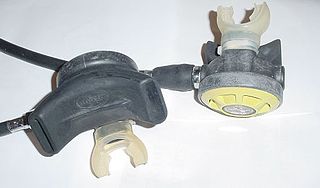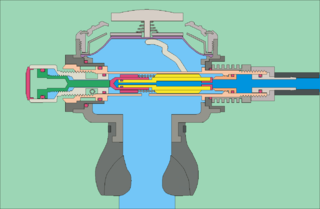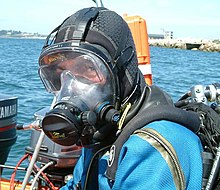
A scuba set, originally just scuba, is any breathing apparatus that is entirely carried by an underwater diver and provides the diver with breathing gas at the ambient pressure. Scuba is an anacronym for self-contained underwater breathing apparatus. Although strictly speaking the scuba set is only the diving equipment that is required for providing breathing gas to the diver, general usage includes the harness or rigging by which it is carried, and those accessories which are integral parts of the harness and breathing apparatus assembly, such as a jacket or wing style buoyancy compensator and instruments mounted in a combined housing with the pressure gauge, and in the looser sense, it has been used to refer to all the diving equipment used by the scuba diver, though this would more commonly and accurately be termed scuba equipment or scuba gear. Scuba is overwhelmingly the most common underwater breathing system used by recreational divers and is also used in professional diving when it provides advantages, usually of mobility and range, over surface-supplied diving systems, and is allowed by the relevant legislation and code of practice.

A rebreather is a breathing apparatus that absorbs the carbon dioxide of a user's exhaled breath to permit the rebreathing (recycling) of the substantially unused oxygen content, and unused inert content when present, of each breath. Oxygen is added to replenish the amount metabolised by the user. This differs from open-circuit breathing apparatus, where the exhaled gas is discharged directly into the environment. The purpose is to extend the breathing endurance of a limited gas supply, and, for covert military use by frogmen or observation of underwater life, eliminating the bubbles produced by an open circuit system and in turn not scaring wildlife being filmed. A rebreather is generally understood to be a portable unit carried by the user. The same technology on a vehicle or non-mobile installation is more likely to be referred to as a life-support system.

A diving regulator is a pressure regulator that controls the pressure of breathing gas for diving. The most commonly recognised application is to reduce pressurized breathing gas to ambient pressure and deliver it to the diver, but there are also other types of gas pressure regulator used for diving applications. The gas may be air or one of a variety of specially blended breathing gases. The gas may be supplied from a scuba cylinder carried by the diver, in which case it is called a scuba regulator, or via a hose from a compressor or high-pressure storage cylinders at the surface in surface-supplied diving. A gas pressure regulator has one or more valves in series which reduce pressure from the source, and use the downstream pressure as feedback to control the delivered pressure, or the upstream pressure as feedback to prevent excessive flow rates, lowering the pressure at each stage.

Standard diving dress, also known as hard-hat or copper hat equipment, deep sea diving suit or heavy gear, is a type of diving suit that was formerly used for all relatively deep underwater work that required more than breath-hold duration, which included marine salvage, civil engineering, pearl shell diving and other commercial diving work, and similar naval diving applications. Standard diving dress has largely been superseded by lighter and more comfortable equipment.

Surface-supplied diving is a mode of underwater diving using equipment supplied with breathing gas through a diver's umbilical from the surface, either from the shore or from a diving support vessel, sometimes indirectly via a diving bell. This is different from scuba diving, where the diver's breathing equipment is completely self-contained and there is no essential link to the surface. The primary advantages of conventional surface supplied diving are lower risk of drowning and considerably larger breathing gas supply than scuba, allowing longer working periods and safer decompression. Disadvantages are the absolute limitation on diver mobility imposed by the length of the umbilical, encumbrance by the umbilical, and high logistical and equipment costs compared with scuba. The disadvantages restrict use of this mode of diving to applications where the diver operates within a small area, which is common in commercial diving work.

A diving helmet is a rigid head enclosure with a breathing gas supply used in underwater diving. They are worn mainly by professional divers engaged in surface-supplied diving, though some models can be used with scuba equipment. The upper part of the helmet, known colloquially as the hat or bonnet, may be sealed directly to the diver using a neck dam, connected to a diving suit by a lower part, known as a breastplate, or corselet, depending on regional language preferences. or simply rest on the diver's shoulders, with an open bottom, for shallow water use.

A diving mask is an item of diving equipment that allows underwater divers, including scuba divers, free-divers, and snorkelers, to see clearly underwater. Surface supplied divers usually use a full face mask or diving helmet, but in some systems the half mask may be used. When the human eye is in direct contact with water as opposed to air, its normal environment, light entering the eye is refracted by a different angle and the eye is unable to focus the light on the retina. By providing an air space in front of the eyes, the eye is able to focus nearly normally. The shape of the air space in the mask slightly affects the ability to focus. Corrective lenses can be fitted to the inside surface of the viewport or contact lenses may be worn inside the mask to allow normal vision for people with focusing defects.

A breathing apparatus or breathing set is equipment which allows a person to breathe in a hostile environment where breathing would otherwise be impossible, difficult, harmful, or hazardous, or assists a person to breathe. A respirator, medical ventilator, or resuscitator may also be considered to be breathing apparatus. Equipment that supplies or recycles breathing gas other than ambient air in a space used by several people is usually referred to as being part of a life-support system, and a life-support system for one person may include breathing apparatus, when the breathing gas is specifically supplied to the user rather than to the enclosure in which the user is the occupant.

In underwater diving, an alternative air source, or more generally alternative breathing gas source, is a secondary supply of air or other breathing gas for use by the diver in an emergency. Examples include an auxiliary demand valve, a pony bottle and bailout bottle.

Vintage scuba is scuba equipment dating from 1975 and earlier, and the practice of diving using such equipment.

A snorkel is a device used for breathing atmospheric air when the wearer's head is face downwards in the water with the mouth and the nose submerged. It may be either a separate unit, or integrated into a swimming or diving mask. The integrated version is only suitable for surface snorkeling, while the separate device may also be used for underwater activities such as spearfishing, freediving, finswimming, underwater hockey, underwater rugby and for surface breathing while wearing scuba equipment. A standard snorkel is a curved tube with a shape usually resembling the letter "L" or "J", fitted with a mouthpiece at the lower end and made from plastic, synthetic elastomers, rubber, or light metal. The snorkel may have a loop or a clip to attach it to the head strap of the diving mask or swimming goggles, or may be tucked between the mask-strap and the head. Some snorkels are fitted with a float valve at the top to prevent flooding if the top opening is immersed, and some are fitted with a water trap and purge valve, intended for draining water from the tube.
Freeflow in underwater diving apparatus is a continuous flow of gas from a storage or supply unit. In scuba diving it is usually undesirable and considered a malfunction, while in surface supplied diving it may be a malfunction or a user selected option in demand systems, or the standard mode of operation in freeflow systems.

An orinasal mask, oro-nasal mask or oral-nasal mask is a breathing mask that covers the mouth and the nose only. It may be a complete independent item, as an oxygen mask, or on some anaesthetic apparatuses, or it may be fitted as a component inside a fullface mask on underwater breathing apparatus, a gas mask or an industrial respirator to reduce the amount of dead space. It may be designed for its lower edge to seal on the front of the lower jaw or to go under the chin.

Rebreather diving is underwater diving using diving rebreathers, a class of underwater breathing apparatus which recirculate the breathing gas exhaled by the diver after replacing the oxygen used and removing the carbon dioxide metabolic product. Rebreather diving is practiced by recreational, military and scientific divers in applications where it has advantages over open circuit scuba, and surface supply of breathing gas is impracticable. The main advantages of rebreather diving are extended gas endurance, low noise levels, and lack of bubbles.

Scuba skills are skills required to dive safely using SCUBA, an acronym for self-contained underwater breathing apparatus, known as a scuba set. Most of these skills are relevant to both open-circuit scuba and rebreather scuba, and also to surface-supplied diving. Certain scuba skills, which are critical to divers' safety, may require more practice than standard recreational training provides.

Surface-supplied diving equipment (SSDE) is the equipment required for surface-supplied diving. The essential aspect of surface-supplied diving is that breathing gas is supplied from the surface, either from a specialised diving compressor, high-pressure gas storage cylinders, or both. In commercial and military surface-supplied diving, a backup source of surface-supplied breathing gas should always be present in case the primary supply fails. The diver may also wear a bailout cylinder which can provide self-contained breathing gas in an emergency. Thus, the surface-supplied diver is less likely to have an "out-of-air" emergency than a scuba diver using a single gas supply, as there are normally two alternative breathing gas sources available. Surface-supplied diving equipment usually includes communication capability with the surface, which improves the safety and efficiency of the working diver.
Diving procedures are standardised methods of doing things that are commonly useful while diving that are known to work effectively and acceptably safely. Due to the inherent risks of the environment and the necessity to operate the equipment correctly, both under normal conditions and during incidents where failure to respond appropriately and quickly can have fatal consequences, a set of standard procedures are used in preparation of the equipment, preparation to dive, during the dive if all goes according to plan, after the dive, and in the event of a reasonably foreseeable contingency. Standard procedures are not necessarily the only courses of action that produce a satisfactory outcome, but they are generally those procedures that experiment and experience show to work well and reliably in response to given circumstances. All formal diver training is based on the learning of standard skills and procedures, and in many cases the over-learning of the skills until the procedures can be performed without hesitation even when distracting circumstances exist. Where reasonably practicable, checklists may be used to ensure that preparatory and maintenance procedures are carried out in the correct sequence and that no steps are inadvertently omitted.

A Diving rebreather is an underwater breathing apparatus that absorbs the carbon dioxide of a diver's exhaled breath to permit the rebreathing (recycling) of the substantially unused oxygen content, and unused inert content when present, of each breath. Oxygen is added to replenish the amount metabolised by the diver. This differs from open-circuit breathing apparatus, where the exhaled gas is discharged directly into the environment. The purpose is to extend the breathing endurance of a limited gas supply, and, for covert military use by frogmen or observation of underwater life, to eliminate the bubbles produced by an open circuit system. A diving rebreather is generally understood to be a portable unit carried by the user, and is therefore a type of self-contained underwater breathing apparatus (scuba). A semi-closed rebreather carried by the diver may also be known as a gas extender. The same technology on a submersible or surface installation is more likely to be referred to as a life-support system.

The mechanism of diving regulators is the arrangement of components and function of gas pressure regulators used in the systems which supply breathing gases for underwater diving. Both free-flow and demand regulators use mechanical feedback of the downstream pressure to control the opening of a valve which controls gas flow from the upstream, high-pressure side, to the downstream, low-pressure side of each stage. Flow capacity must be sufficient to allow the downstream pressure to be maintained at maximum demand, and sensitivity must be appropriate to deliver maximum required flow rate with a small variation in downstream pressure, and for a large variation in supply pressure, without instability of flow. Open circuit scuba regulators must also deliver against a variable ambient pressure. They must be robust and reliable, as they are life-support equipment which must function in the relatively hostile seawater environment, and the human interface must be comfortable over periods of several hours.

Human factors in diving equipment design concern how the needs of the diver should influence the design of diving equipment. The underwater diver relies on various items of diving and support equipment to stay alive and to perform planned tasks during a dive.



































